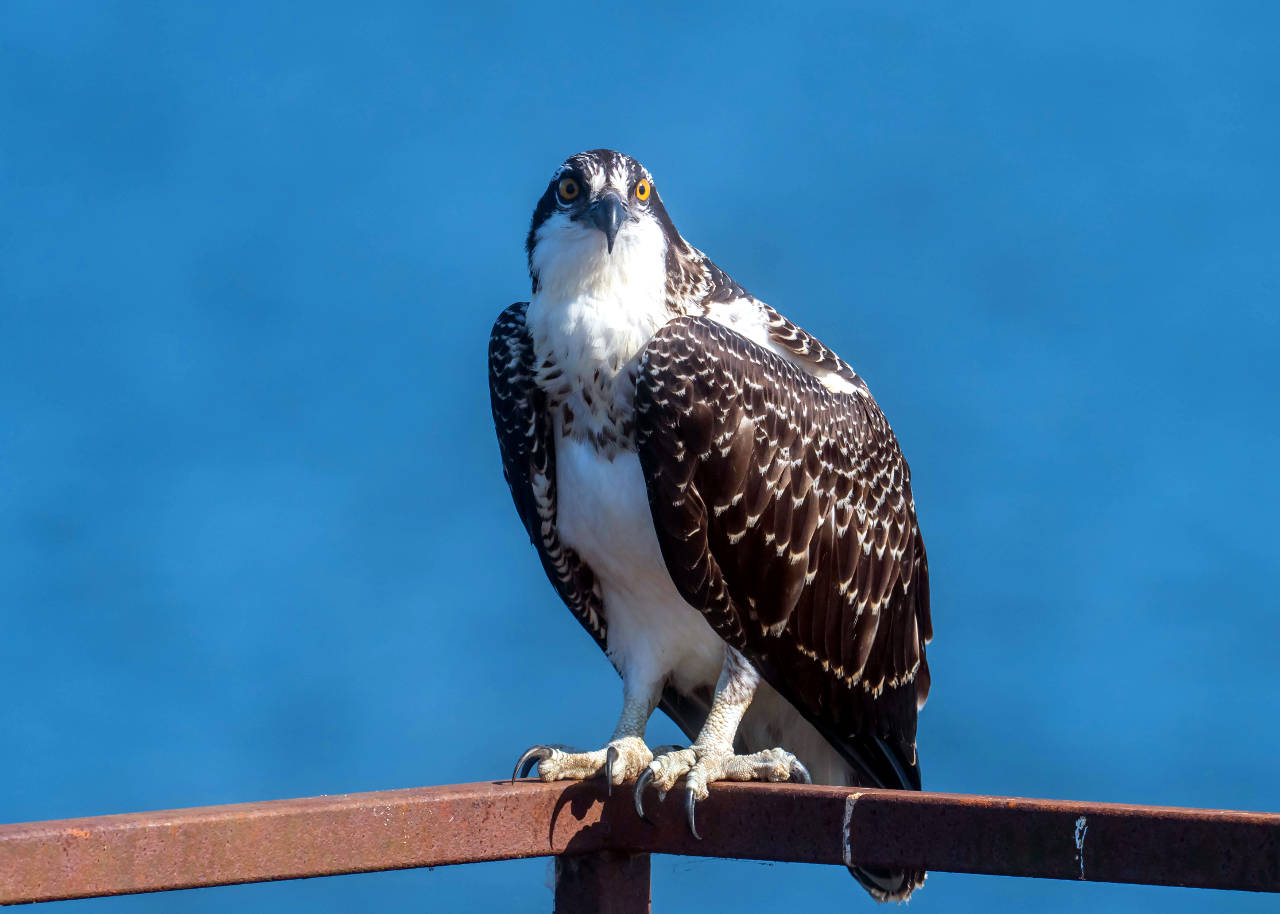By Dianna Moore
Grays Harbor Audubon
This photo of a young female Osprey clearly shows the “necklace” or spotted breast feathers denoting a female and the white-edged feathers of the upper wings and back identifying her as an immature bird. She has already fledged but spends a lot of time near the nest where her father is still bringing fish to her.
General Description: Osprey are large slender hawks with a white throat, breast and belly, long narrow wings and long legs. Their head is black/dark brown on top and down the back and they have a dark stripe across the eyes. As usual with raptors, the female is larger than the male. Both sexes are 21 to 23 inches long with wing spans of 51 to 79 inches in length and weigh from 49 to 74 ounces. They can often be heard before being seen. Check out their calls in the following link and click on “Listen” (http://birdweb.org/birdweb/bird/osprey).
Habitat: Osprey are found near water and prefer water surrounded by forest and large enough to support medium-sized fish.
Behavior: These birds can be seen flying with slow steady wingbeats and a bit of gliding as they fly over shallow water searching for fish. They often hover in one place just before diving feet first to grab their prey, then fly off with the fish facing forward. Their aerial displays during courtship are just one of the many reasons to pull up a chair or a car to watch the show.
Diet: Nearly 99% of prey of the Osprey is fish. I have personally watched the pair out at the Hoquiam STP bring in other prey for their young, including snakes, but usually it’s a fish. If things are tough, a small mammal will also do just fine. But we have a lot of fish in our Harbor area, so something in the five to 16-inch size is usually not a problem to find.
Nesting: Osprey form pair bonds, usually with the same mate, and often use the same nest year after year, adding new sticks as needed. The male shows up first to claim the territory then the two work to repair or add to the nest. These nests are often up to seven feet across and five feet deep, and they usually hold up better than the local eagle nests. They are found at the very top of a snag or on man-made structures, from pilings over the river to field lights on sports fields. The female lays two to four eggs and both sexes incubate the eggs for 38 to 43 days. The female stays on the nest while the male does most of the hunting. The young begin leaving the nest at about 44 to 59 days of age but stay in the area for feeding, then training to hunt for themselves. The female usually leaves first while the male continues to teach the young how to catch their own prey.
Migration: Washington Osprey migrate south beginning in late August through September. They may go as far south as Mexico then return to the PNW in March or April.
Conservation Status: Following the ban of DDT in 1972, the population of Osprey began to recover. This is a slow process because of their fealty to their nest-site. One of the success stories is their acceptance of artificial nest platforms, especially over power poles. Our own Grays Harbor PUD has worked with various agencies to build these platforms, making it a win-win situation for both the birds and our power grid, and we are grateful for their co-operation.
When and Where to Find on Grays Harbor: Because Osprey nests are seen on the tops of trees and light standards, they are generally quite easy to find and observe. The nest out at the Hoquiam STP on Paulson Rd. is easily viewed from the side of the road. Two youngsters fledged off that nest a few weeks ago and can often be seen nearby waiting to be fed. Their parents often perch on the nearby poles farther down near the corner with Airport Rd. There has been a nest on the North Beach HS sports field lights just outside Ocean Shores and the two youngsters off that nest are still in the area. Cell towers are a favorite nesting/perching spot, so check them out too.



